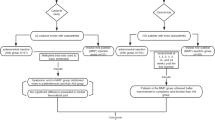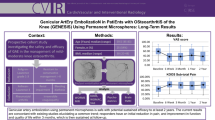Abstract
Introduction
Chronic pain is one of the leading causes of reduced quality of life in the USA, with knee pain commonly reported. Multiple therapeutic modalities are traditionally utilized for pain management; however, some patients may have pain refractory to these techniques. Cooled radiofrequency ablation (c-RFA) of the geniculate nerve is a growing and promising therapy offering a potentially long-term solution to chronic knee pain.
Methods
This study assessed the efficacy, average duration of relief, and potential adverse events using a retrospective chart review of 406 procedures. A two-tailed paired t test was used to assess the statistical significance between pre-RFA vs. post-RFA visual analog scale (VAS) pain scores self-reported by patients. An analysis of variance (ANOVA) test was used to evaluate for statistical differences in pre-RFA pain scores and post-RFA pain scores among the categories of age, sex, body mass index (BMI), and diagnosis group.
Results
The mean percent in pain improvement calculated was 65.5% with an average duration of relief of 7.20 months. The average pre-RFA pain score on the VAS was 6.26 out of 10 and 2.59 out of 10 post-RFA. The ANOVA post-RFA pain scores demonstrated statistically significant differences among the categories of age and sex. A total of 54 adverse events were reported, including worsening pain, numbness, paresthesia, and knee swelling.
Conclusion
The study demonstrated that c-RFA can potentially be utilized as an alternative safe therapy for chronic knee pain, providing pain relief with a relatively prolonged duration. Inherent challenges of retrospective studies remain a part of the limitations of this study.
Similar content being viewed by others
Data Availability
The datasets generated during and/or analyzed during the current study are available from the corresponding author on reasonable request.
References
Dahlhamer J, Lucas J, Zelaya C, et al. Prevalence of chronic pain and high impact chronic pain among adults—United States, 2016. MMWR. 2018;67:1001–6.
Abd-Elsayed A, Martens JM, Fiala KJ, Schatman ME. Radiofrequency ablation of the trochanteric branches of the femoral nerve for the treatment of greater trochanteric syndrome. J Pain Res. 2022;15:115–22. https://doi.org/10.2147/JPR.S343165.
Skelly AC, Chou R, Dettori JR, et al. Noninvasive nonpharmacological treatment for chronic pain: a systematic review update. Rockville (MD): Agency for Healthcare Research and Quality (US); 2020 Apr. Report No.: 20-EHC009.
Flynn DM. Chronic musculoskeletal pain: nonpharmacologic, noninvasive treatments. Am Fam Physician. 2020;102(8):465–77.
Billesberger LM, Fisher KM, Qadri YJ, Boortz-Marx RL. Procedural treatments for knee osteoarthritis: a review of current injectable therapies. Pain Res Manag. 2020;18(2020):3873098. https://doi.org/10.1155/2020/3873098.
Seale C, Connolly BR, Hulk K, Yu GG, Nagpal AS. The use of radiofrequency in the treatment of pelvic pain. Phys Med Rehabil Clin N Am. 2021;32(4):683–701. https://doi.org/10.1016/j.pmr.2021.05.006.
Watanabe I, Masaki R, Min N, et al. Cooled-tip ablation results in increased radiofrequency power delivery and lesion size in the canine heart: importance of catheter-tip temperature monitoring for prevention of pop** and impedance rise. J Interv Card Electrophysiol. 2002;6(1):9–16. https://doi.org/10.1023/a:1014140104777.
Kidd VD, Strum SR, Strum DS, Shah J. Genicular nerve radiofrequency ablation for painful knee arthritis: the why and the how. JBJS Essent Surg Tech. 2019;9(1):e10. https://doi.org/10.2106/JBJS.ST.18.00016.
Abd-Elsayed A, Anis A, Kaye AD. Radio frequency ablation and pulsed radiofrequency for treating peripheral neuralgias. Curr Pain Headache Rep. 2018;22:5. https://doi.org/10.1007/s11916-018-0657-9.
Kim IJ, Kim HA, Seo YI, et al. Prevalence of knee pain and its influence on quality of life and physical function in the korean elderly population: a community based cross-sectional study. J Korean Med Sci. 2011;26(9):1140–6. https://doi.org/10.3346/jkms.2011.26.9.1140.
Samaan A, Spinner D. Shoulder ablation approaches. Phys Med Rehabil Clin N Am. 2021;32(4):675–82. https://doi.org/10.1016/j.pmr.2021.07.002.
Conger A, Gililland JM, Anderson LA, Pelt CE, Peters CL, McCormick ZL. Genicular nerve radiofrequency ablation for the treatment of painful knee osteoarthritis: current evidence and future directions. Pain Med. 2021;22(Suppl_1):S20–3. https://doi.org/10.1093/pm/pnab129.
The National Council on Aging. NCOA.org. 2023. https://ncoa.org/article/get-the-facts-on-falls-prevention. Accessed 4 Jan 2024.
Kapural L, Lee N, Neal K, Burchell M. Long-term retrospective assessment of clinical efficacy of radiofrequency ablation of the knee using a cooled radiofrequency system. Pain Physician. 2019;22(5):489–94.
Bellini M, Barbieri M. Cooled radiofrequency system relieves chronic knee osteoarthritis pain: the first case-series. Anaesthesiol Intensive Ther. 2015;47(1):30–3. https://doi.org/10.5603/AIT.2015.0003.
Choi WJ, Hwang SJ, Song JG, et al. Radiofrequency treatment relieves chronic knee osteoarthritis pain: a double-blind randomized controlled trial. Pain. 2011;152(3):481–7. https://doi.org/10.1016/j.pain.2010.09.029.
Conger A, Gililland J, Anderson L, Pelt CE, Peters C, McCormick ZL. Genicular nerve radiofrequency ablation for the treatment of painful knee osteoarthritis: current evidence and future directions. Pain Med. 2021;22(Suppl_1):S20–3. https://doi.org/10.1093/pm/pnab129.
Bryan DS, Parvizi J, Austin M, et al. Obesity and total joint arthroplasty. J Arthroplasty. 2013;28(5):714–21. https://doi.org/10.1016/j.arth.2013.02.011.
Michaud K, Cooper P, Abd-Elsayed A, et al. Review of radiofrequency ablation for peripheral nerves. Curr Pain Headache Rep. 2021;25:63. https://doi.org/10.1007/s11916-021-00981-0.
Orhurhu V, Urits I, Grandhi R, et al. Systematic review of radiofrequency ablation for management of knee pain. Curr Pain Headache Rep. 2019;23:55. https://doi.org/10.1007/s11916-019-0792-y.
McCormick ZL, Patel J, Conger A, Smith C. The safety of genicular nerve radiofrequency ablation. Pain Med. 2020;22(2):518–9. https://doi.org/10.1093/pm/pnaa355.
Myles PS, Myles DB, Galagher W, et al. Measuring acute postoperative pain using the visual analog scale: the minimal clinically important difference and patient acceptable symptom state. Br J Anaesth. 2017;118(3):424–9. https://doi.org/10.1093/bja/aew466.
Abd-Elsayed A, Strand N, Gritsenko K, et al. Radiofrequency ablation for the knee joint: a survey by the American Society of Pain and Neuroscience. J Pain Res. 2022;27(15):1247–55. https://doi.org/10.2147/JPR.S342653.
Kingsbury SR, Hensor EM, Walsh CA, Hochberg MC, Conaghan PG. How do people with knee osteoarthritis use osteoarthritis pain medications and does this change over time? Data from the Osteoarthritis Initiative. Arthritis Res Ther. 2012;15(5):R106. https://doi.org/10.1186/ar4286.
Funding
No funding or sponsorship was received for this study or publication of this article.
Author information
Authors and Affiliations
Contributions
Dr. Alaa Abd-Elsayed has contributed to the project through his clinical work and mentorship. Andrew Matta conducted chart review and gathering of data, writing the manuscript, data analysis and charts, editing, and submission of the manuscript. James Nitz assisted with chart reviewing, writing the manuscript, data analysis and editing. Lukas Henjum contributed through editing and addressing the reviewers’ comments into the manuscript. Barnabas Shiferaw assisted with the data organization for the ANOVA and editing the final form of the manuscript. Raven May wrote the introduction of the manuscript. Kenneth Fiala was mentoring, supervising, and editing the finalized form of the manuscript.
Corresponding author
Ethics declarations
Conflict of Interest
Alaa Abd-Elsayed is an Editorial Board member of Advances in Therapy and a consultant of Avanos. Alaa Abd-Elsayed was not involved in the selection of peer reviewers for the manuscript nor any of the subsequent editorial decisions. The other authors (Andrew Y Matta, James N Nitz, Lukas J Henjum, Barnabas T Shiferaw, Kenneth J Fiala and Raven May) declare no conflict of interest.
Ethical Approval
Institutional review board (IRB) application submitted to the University of Wisconsin IRB and minimal risk research exemption was granted owing to the study’s retrospective nature and lack of contact with the subjects in the study. Compliance with patient confidentiality was maintained throughout the study.
Rights and permissions
Springer Nature or its licensor (e.g. a society or other partner) holds exclusive rights to this article under a publishing agreement with the author(s) or other rightsholder(s); author self-archiving of the accepted manuscript version of this article is solely governed by the terms of such publishing agreement and applicable law.
About this article
Cite this article
Abd-Elsayed, A., Matta, A.Y., Nitz, J.N. et al. Efficacy of Cooled-Radiofrequency Ablation of the Genicular Nerve as Treatment for Chronic Knee Pain: A Retrospective Study. Adv Ther 41, 2859–2867 (2024). https://doi.org/10.1007/s12325-024-02892-z
Received:
Accepted:
Published:
Issue Date:
DOI: https://doi.org/10.1007/s12325-024-02892-z




